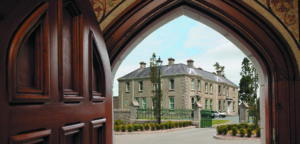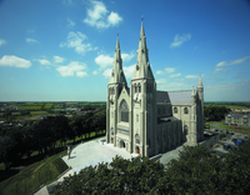50TH ANNIVERSARY OF THE OPENING OF
OUR LADY, QUEEN OF PEACE CHURCH, AUGHANDUFF
HOMILY GIVEN BY
ARCHBISHOP SEÁN BRADY
SUNDAY 23 SEPTEMBER 2007
We are here today because a certain man once said: “Do this in memory of me”. It was the night before he was crucified. Jesus had just taken bread and changed it to his body. He had taken a cup of wine, changed it into his blood. In other words, he had just celebrated the first Mass. Then he gave this command to his followers: “Do this in memory of me”.
Do what I have done to remind yourselves that I, your Lord and Master, have loved you to the end. I, your Lord and Master, love you so much that I am prepared to give my life for you. I, your Lord and Master, am going to give my life, not in some heroic glorious gesture of courage and defiance. I, your Lord and Master, am going to humble myself, even to accepting death, death on a cross, the horrible death of a criminal, preceded by an even more horrible scourging as Mel Gibson’s film The Passion illustrated so vividly. With that command he gave to his disciples the power to do what he was commanding them to do.
Of course, none of this makes any sense unless we remember that it was all done out of love. The love of God for sinner like me and you. So the Church has never, ever forgotten that Last Supper. That last command – Do this in memory of me.
That is why that for many years before this beautiful Church of Our Lady Queen of Peace was built, Mass was celebrated in Aughanaduff School. It was located, on the top of the hill, where John and Nellie Mackin now have their house. Parishioners came from surrounding townlands to the school to attend Mass which was celebrated on Sundays and Holy Days at nine o’clock. But the building was quite small and conditions were cramped for those attending Mass. People were very grateful to have Mass celebrated in the school but it was clear for many years that a new Church would have to be built to meet their needs. Indeed there was a lot of discussion, I understand, about the building of a new Church. When John O’Neill was appointed Parish Priest in 1946, Cardinal D’Alton wrote to him. He said he was glad that he, Father O’Neill, had already realised the necessity of building a church that will serve the needs of the people of this district. The Cardinal went on to say that: ‘Saying Mass on Sundays in the school was out of keeping with the sublime dignity of the holy sacrifice. It was a poor substitute for a church because a church would be a permanent for Our Lord in the Blessed Sacrament and a centre of devotion for the people. Since this was 1946, the Archbishop suggested that the new Church might be dedicated to Our Lady Queen of Peace. It would be an act of thanksgiving to God and of homage to his blessed mother that in the recent World War, which had just ended in 1945, the people of this area were preserved from the ravages of war. Archbishop D’Alton ended his letter with the hope that Father O’Neill’s appeal would meet with a generous response. He said: ‘God will richly reward all who make a contribution whether great or small’.
Well that is exactly what happened. The appeal to have a new church met with a terrific response. We are having commemorations of all sorts of events in the past.
Two weeks ago I was in Dungannon for a commemoration of the Flight of the Earls. A sad event really in the history of our country. Last Sunday I was in Paris for a celebration of the death of Archbishop Dominic Maguire. He was the Archbishop who came after St Oliver Plunkett, who was appointed in 1683/4 but in 1691, after the Treaty of Limerick, and the defeat of the Battle of the Boyne, he had to leave Ireland and spend the last sixteen years of his life in Paris, in exile. That was also a sad commemoration. But today I am glad we are having a joyful celebration.
We are here to celebrate the fact that the people of this community, fifty years ago, took on the ambitious project of building a new church. Building a new church at any stage is a big challenge for a parish. It was a huge undertaking in the 1950s because it was a time of high unemployment and emigration. But, to raise funds for the new church a local committee was set up to help the priests of the parish – Father O’Neill and Father Brendan McDonald. The new Church Committee had two functions
1. To organise events and activities to raise funds for the building of the church and secondly,
2. To oversee the construction work.
This Sunday’s Gospel is about God and money and really I can’t think of any better example of how people could use their money and the example of the building of this Church here in the 1950s.
The Building Committee worked tirelessly over five years. Its tremendous success was due, in no small measure, to the energies of the Chairman, Owen Murphy and Vice Chairman Francis Quinn. May the Lord have mercy on their souls. The Secretary was Michael Murphy, and the Treasurer was Peter McDonnell Snr. The Committee was: Father McDonald, Francis Loy, Patrick Campbell, Arthur Garland, Pearse McGeough, Jack Murphy, Tommy McVerry, James McVerry, and Thomas Walsh.
Down through the years the membership changed of course and I understand that the only surviving members of the Committee are: Louis McDonnell, Michael McKinley, James McKinley, Peter McParland and Emmett McCreesh. All the others are now deceased. May they rest in peace.
One thing I noticed about the Committees in the 1950s only men were appointed to committees. That doesn’t mean that it was only the men who worked hard to ensure the success of the many events. The women were involved, up to their ears, in organising raffles, selling tickets at Bazaars, cooking at the dances and card playing as well as organising guest-teas. The Committee met every Monday night and after the meetings they went for tea to the home of the McKinleys where the debates and heated arguments continued on. The methods chosen were from the collections – house-to-house collections; bazaars; carnival dances and marquee dances; raffles and sweeps; guest teas; card games; local appeals for donors; appeals to emigrants – mainly in America and England. There is a record of a decision of the 18th October 1954 when Mr P Campbell got eight packs of cards at a cost of £1. Some of your may remember the big raffle of 1955 when the 1st prize was an Austin A30 car.
In early 1954 it was decided that the Church would be built here in Aughanaduff and a site was acquired from Bernard McKinley, father of Michael and James McKinley who served as members of the new Church Committee. The Architect was Mr Simon Leonard from Dublin. Work began on 5 July 1954.
There was also a wonderful Ladies Committee presided over by Miss Mollie McKinley and helped by Misses Mary McDonnell; Marie Murphy; Josie McCoy and Anne McCreesh.
There was loud praise too for the help from the American exiles especially Peter and Mollie Murphy in New York, Dr P J and Michael Hughes in Pennsylvania, who gave the bell; Misses Brigid and Katie Faughey who gave the altar and the altar rails and there were many others including Sister Bernadette Owen who was in the Mount Carmel Convent in New York.
The foundation stone was laid at the end of May 1955 and the Church opened in June 1957 in the presence of Bishop O’Callaghan of Clogher, who was a native of the neighbouring parish and Bishop Austin Quinn, Bishop of Kilmore, the Bishop who confirmed me and sent me to Maynooth to study for the priesthood and therefore has a special place in my affections.
The preacher said: “that the dedication of any Church has always been an occasion of great spiritual joy and thanksgiving”. But he said: “the sacrifices which you have made are indeed great and today is an occasion for rejoicing because it is a day which has seen the fulfilment of the hopes and dreams of many generations in this district….. Your ancestors, in this parish, had to endure great sufferings and persecution in order to preserve the faith”. He said, “Let us remember our ancestors and ask God to instil into us the great spirit of faith which characterised them. Let us ask God that we may always preserve it and pass it unsullied to the generations to come”.
That is, I think, one of the great merits of today’s celebration. We recall the fact that this Church was built with tremendous local effort. There was a lot of direct labour, a lot of voluntary labour given. All sections of the community were involved. It took a huge effort. In the process, I am sure, it built up a great community spirit and that is part of the joy of dedicating a church. And now, the challenge is to preserve that faith and to pass it on to the generations to come.
Let me quote the words again of the preacher of the day. He said: “This little Church stands as an example to all. May Our Lady obtain for us all the graces so that we may realise the necessity of doing penance, not just for our own sins but for the sins of the world. Let us be ever faithful to the recitation of the family rosary. This is a great devotion to our Blessed Mother to which Irish people had always been faithful in the days of persecution. When it wasn’t possible to assist at Mass, they resorted to the Rosary and their fidelity obtained for them graces to endure their trials”. He said that “the new Church would bring blessings to the people of this parish as this Church would stand as a lasting memorial to the faith and generosity of the people”.
We cannot omit to mention the work of refurbishment and re-dedication done in this Church during the time when Father John McGrane was Parish Priest here. It was re-dedicated in 1986 by Cardinal Ó Fiaich.
My thanks go to Frank McCreesh whose has compiled this wonderful history and I would love to see it being developed into a little booklet because it is a glorious history – a glorious chapter – in the history of this historic region of Fews in South Armagh.
Today we thank God for the faith and the example of those people. We ask God’s Holy Spirit to help us to, first of all, know Jesus Christ ourselves, personally, and to imitate him so powerfully that everyone around us will want to imitate Him in the same way, and that is a big challenge.
The Church is, first of all, a House of Prayer, a place where Jesus is present. Where people come to adore Him and to praise Him and to thank Him and to make their petitions. One petition I want you to make constantly here and I would love to see is a time of adoration of the Blessed Sacrament each week or each month, dedicated to this intention, that we renew our faith in the reality of those who are ordained for the service of the people either as bishops; as priests or as Deacons. Those who are ordained and those who are married, receive these sacraments not primarily for their own use or perfection but to serve you, the people.
The men and women who built this Church had a wonderful idea of that call to service – to serve each other. That is why they met and they planned and they worked. We must try and revive that spirit.
I am sure that they got great joy and satisfaction just seeing this wonderful Church. Our job today is to rebuild the monument of faith – the faith of ourselves and of our neighbours in Christ Jesus present in our midst. We must do that through our devotion to Mary, Queen of Peace, Mother of Jesus and our mother too.
AMEN



You must be logged in to post a comment.